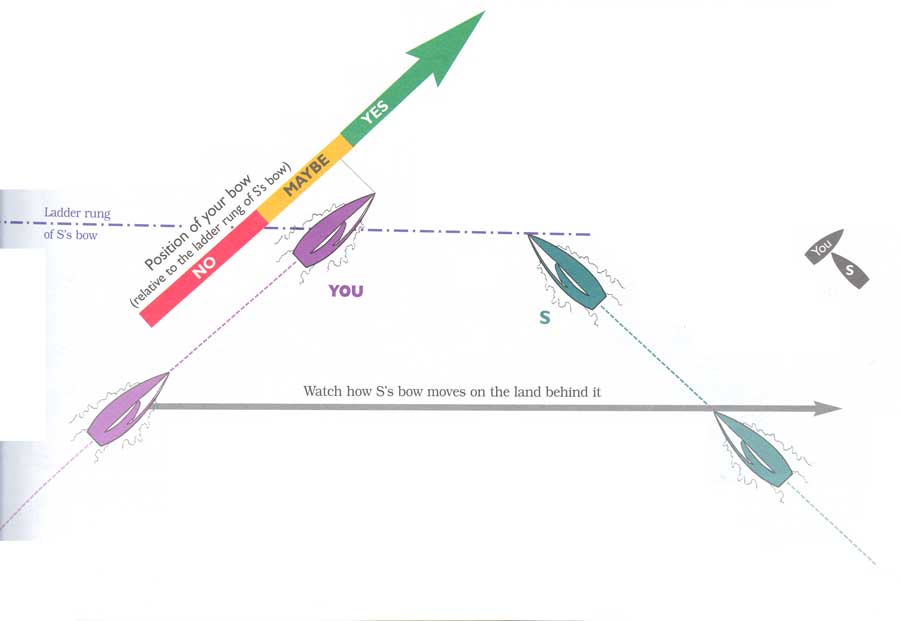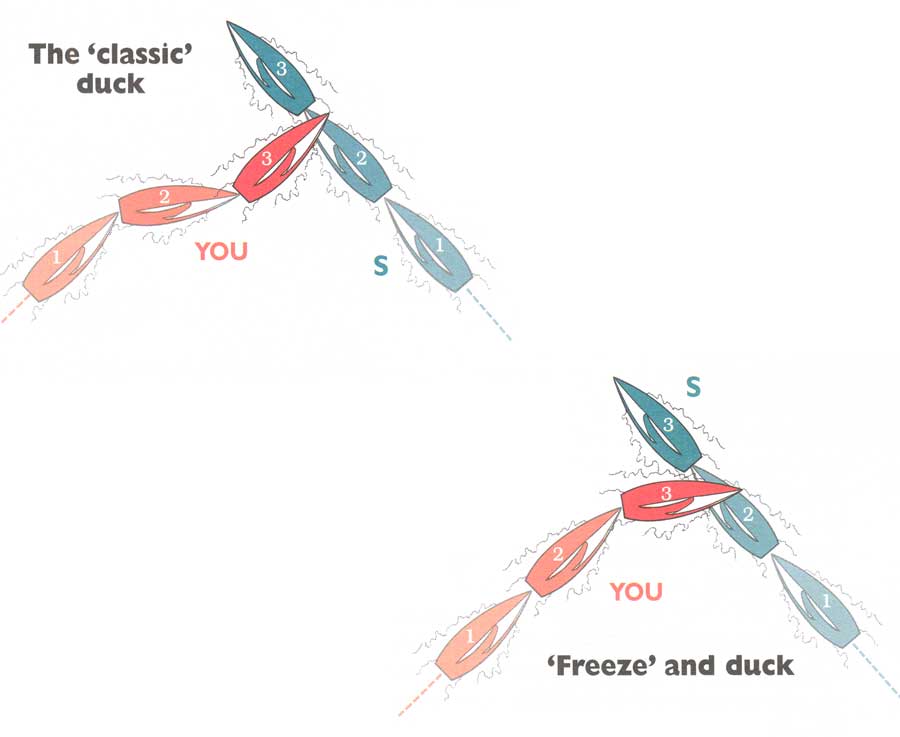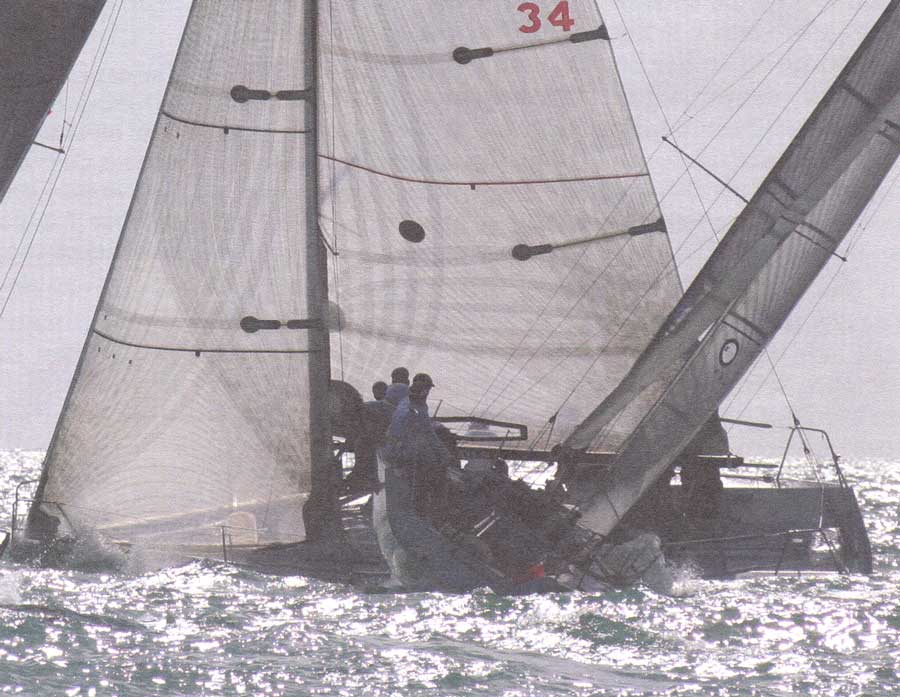Converging on Port Tack
by David Dellenbaugh
By far the most common way that two boats interact on a beat is when they come together on opposite tacks. This happens many times during a race, and the tactics you choose to employ in each case can make a huge difference in your race results.
We will discuss tactical options for the port tacker. The obvious first step
is keeping a good lookout so you know when another boat is coming.
The next step, and probably the most important when boats converge, is to
mentally review your strategic game plan. In simple terms, do you like the
right side, or the left? This will have a huge impact on your tactical
decision and is therefore critical to know before you engage the other boat.
| A. Can you lee-bow? When you converge with a starboard tacker on a beat, itís critical to know where you stand. If you canít cross in front of them, can you at least tack into a safe leeward position? The ability to do this is a strong tactical weapon, so you must get good at judging your relative position as the boats converge. |
 |
| If you want to make a lee-bow Ďstickí, you must almost always be Ďbow aheadí of the approaching starboard tacker. The distance you need to be ahead depends on a number of factors including your boat type, the skill of your crew, wind velocity and wave conditions. In flat water and medium breeze, a good sailor in a light dinghy may be able to execute a successful lee-bow tack when they are just bow-even with (i.e. on the same ladder rung as) the starboard tacker. But if youíre sailing a heavy keelboat in light wind and big chop, you may actually need to be crossing the other boat before you can tack into a safe leeward position. A rough guide is that you need to be about a half boatlength ahead of the other boat. In other words, if the boats kept going straight, you can normally make a successful lee-bow tack when the starboard-tack boat will hit you amidships (or further aft) on your leeward side. |
| One way to tell where you stand with the other boat is to watch how Sís bow moves relative to the land behind it. If her bow appears stationary on the land, then the point on your boat where you are sitting is roughly equal to the race with her bow. For example, if you are in the middle of your boat and Sís bow is not moving either way on the land, you know they will hit you about where you are sitting. Depending on the conditions, you may be able to tack in a safe leeward position. |
When you meet another boat on the race course, you have several tactical
objectives:
1) To come out of that situation so you are headed in the correct direction
strategically. This is the most important goal.
2) To lose as little time as possible while maneuvering around the other
boat. In other words, donít lose sight of the big picture, and
3) To force the other boat to go in the unfavored direction. This is a
secondary goal unless you are in a situation (e.g. a match race or a fight
to win the series) where you really need to beat that competitor.
As you converge with a starboard tacker (S), keep the following things in
mind:
ē S has the right of way, so be sure to keep clear and avoid fouling her.
There are, however, some limits on Sís ability to change course near you
(see rule 16), and these can work in your favor. For example, if you bear
off to duck S, she cannot turn into a tack if her stern swings and causes
you to change your course immediately to avoid her.
ē While you are converging with another boat, itís usually a good idea to
bear off slightly and build a little extra speed. By coming into the
situation faster than normal, you have more tactical options and better
maneuverability relative to your competitor.
ē One big question for the port tacker is whether or not she is far enough
advanced in the race that she can tack into a safe leeward position on the
starboard tacker (see left), No matter which side of the course you like,
the answer to this question will make a critical difference in your tactics,
so learn how to judge this accurately.
Protecting the left side.
| B. When you want to keep going right If youíre on port tack and you like the right side of the course, donít tack to avoid a starboard tacker. Instead, plan ahead so you can duck them and continue on port tack. |
 |
| ē The course you choose to steer when ducking a starboard tacker can
make a big difference tactically. If you know that S will continue
straight ahead on starboard tack, your best course is to bear off early
(position 2) and then gradually turn up to closehauled as your bow gets
to Sís transom. By passing close behind Sís stern on a closehauled
course, you minimize your distance lost to leeward during this maneuver. ē Unfortunately, you never know whether S will keep going straight or not. If you make your duck as shown above, you allow (or even invite) S to tack right in front of you at position 2 (when your bow is aimed behind her stern). To prevent this donít bear off until the last moment. By holding your course and aiming at S for as long as possible, you make it hard for her to tack (because any time she changes course she must give you room to keep clear under rule 16.1). Though you end up passing Sís transom on a close reach (and thereby lose some VMG to windward), this tactical maneuver increases your chances of being able to continue on port tack to the right. |
When your gameplan says go left, itís easy being the port tacker because you
are already on the left side of the other boat. You have two options:
ē Tack well before you meet up with the other boat. This makes sense because
if you like the left you shouldnít keep sailing on port tack - just get onto
starboard as soon as you can. Make sure you tack at least 4 or 5 boatlengths
to leeward of S; if you go any closer she may end up pinning you on
starboard tack.
ē Tack in a safe leeward position on S (assuming you are far enough advanced
to do this). This is a good way for you to head the right way and force your
closest competitor to go the wrong way, plus you avoid the chance that S may
pin you.
When you like the right.
If your strategy says to keep going on port tack, this is more complicated
because you must switch sides with the approaching starboard tacker (and
they have the right of way). There are three ways to do this:
 |
| The classic technique for ducking a starboard tacker (S) is to bear
off early so you can return to a closehauled course by the time you
cross behind Sís transom. However, if you aim behind S too early it will
be easy for her to tack in front of you. Instead, hold your boat on a
converging course longer than usual; donít aim your bow behind the
leeward corner of Sís transom until itís too late for her to tack. Photo by JH Peterson |
ē Cross ahead of S. This is obviously the preferred way of getting to the
right, but you must be more than a boat length ahead of S in order to do it.
If it looks close, you can always ask (loudly) if they will let you cross.
Yell out something like, ďTack or cross?Ē Often they will let you go across
so you donít lee-bow them.
ē Duck behind S. This is a safe way of getting to the right, though many
sailors are reluctant to give up distance by bearing off. However, if you
like the right a lot, going there will gain more than you lose ducking.
The only problem with this tactic occurs when S tacks right in front of you.
To avoid this, try yelling ďHold your course.Ē This is a non-binding hail,
but it lets them know that they should be careful about changing their
course. Another option is to do the Ďfreeze and duckí.
ē Tack on Sís lee bow. This may seem like a strange way to go right, but if
you can quickly pinch off S youíll be able to tack again. This works only if
the cost of two tacks is less than the two boat lengths or so that you would
have lost by ducking.
Dave publishes the newsletter Speed & Smarts. For a subscription call:
800-356-2200 or go to:
www.speedandsmarts.com.
All contents are copyright (c) 2007 by
Northern Breezes, Inc. All information contained within is deemed reliable
but carries no guarantees. Reproduction of any part or whole of this
publication in any form by mechanical or electronic means, including
information retrieval is prohibited except by consent of the publisher.